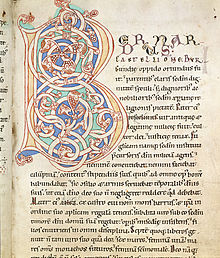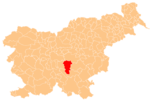Стиче аббатство
| Стиче аббатство | |
|---|---|
 Стиче аббатство | |
| Религия | |
| Руководящий орган | Цистерцианский орден |
| Расположение | |
| Расположение | Славеня , Словена, Славеня, Словена, Словена , Словения |
| Географические координаты | 45 ° 57′25,19 ″ с.ш. 14 ° 48′20,70 ″ E / 45,9569972 ° N 14,8057500 ° E |
| Архитектура | |
| Architect(s) | Francesco Ferrata (1694), Candido Zulliani (middle 18th century) |
| Founder | Pellegrinus I., Patriarch of Aquileia |
| Official name: Stična - Abbey of Stična | |
Аббатство Стична ( Словен : Цистерцианская аббатство Стючна , также против ; немецкий : Клостер Ситтич , Латинский: Ситтикам ) - самый старый монастырь в Словении . Это единственный цистерцианский монастырь в стране, который все еще действует (другой был Аббатство Костанджевика и Костанджевика на Крка ). Его мать -дом был Аббатством Рейн и Австрии .
История
[ редактировать ]Хартия Фонда аббатства была опубликована в 1136 году Пеллегрином I , патриархом Акквийи , хотя монашеская жизнь началась годом ранее, в 1135 году. Монастырь в Стючне быстро стал важным религиозным, культурным и экономическим центром.
В дополнение к обычной школе, монастырь также управлял музыкальной школой, где, как полагают, композитор ренессанса Якобус Галсус получил самое раннее музыкальное образование. Успешную жизнь монастыря была затруднена османскими набегами, и была сожжена и разграблена дважды. В 1784 году император Джозеф II отменил монастырь, распущенный под реформами изефины , но в 1898 году он снова был переселен монахами из аббатства Меерерау на берегу озера Констанс .
During the Second World War, the Partisans use the abbey as a prison for priests that they had captured.[1][2][3]
Stična manuscript
[edit]The monastery's scriptorium was already producing illuminated Latin manuscripts in the 12th century, and it was here that the Stična manuscript, written in Slovene, was produced in the 15th century.

Architecture
[edit]In terms of architecture, abbey has been repeatedly modified, leaving Romanesque and Gothic traces in Baroque buildings. The oldest core of the abbey has been preserved. The abbey has a basilica dedicated to Our Lady of Sorrows, which serves as a parish church. The abbey and Romanesque basilica are recognized as cultural monuments of national significance.
List of abbots
[edit]
| The list of abbots[4] | |
|---|---|
| Name | Period |
| Vincencij | 1135/36–1150 in 1163–1167/68 |
| Aldeprand | between 1150–1163 |
| Folknand | 1167/68–1180 |
| Bernold | 1181–21.
februar 1226 |
| Konrad | approx. 1230–approx. 1250 |
| Janez Gall | approx. 1250–approx. 1260 |
| Ditrik | approx. 1260–1266/67 |
| Konrad | 1266/67–approx. 1280 |
| Henrik | approx. 1280–1302 |
| Rudolf | 1303–approx. 1314/15 |
| Friderik Limpach | approx. 1315–approx. 1321 |
| Nikolaj Hmeljniški | approx. 1321–approx. 1326 |
| Eberhard Planinski | approx. 1326–1332 |
| Štefan | 1332–1333 |
| Oton | 1333–1335/36 |
| Janez | 1336–1341 |
| Nikolaj | 1341–1348 |
| Peter | 1348/49–1360 in 1365–1366 |
| Arnold | 1360–1365 in 1366–1370 |
| Jakob | 1370/71–1382 |
| Andrej Čreteški | 1382–1387/88 |
| Albert Lindeški | 1388–13.July 1405 |
| Peter Limschak | 13. July 1405 – 1427/28 |
| Lavrencij Forrer | 1427/28–1431/32 |
| Emerik Perenny | 1432–approx. 1441 |
| Matej Zaletel | 7.February 1441–10.September 1449 |
| Gerhard | 1449/50–1450 |
| Ulrik | approx. 1450–1481 |
| Ožbalt | 1481/82–1487/88 |
| Tomaž | 1487/88–13.December 1494 |
| Martin | 13.December 1494 – 1499/1500 |
| Janez | 1499/1500–approx. 1511 |
| Tomaž | 1511/12–before 13.March 1516 |
| Urban Gall | before 13.March 1516–22.August 1523 |
| Janez Glavič | 22.August 1523–4. September 1530 |
| Klemen Gutsold | before 14.November 1530 – 1533/34 |
| Janez Cerar | 1533/34–1549 |
| Wolfgang Neff | before 6.March 1549–18.March 1566 |
| Janez Zeisel | 24.April 1566–21.September 1576 |
| Jakob Klafferle | 31. januar 1577–7. marec 1580 |
| Lavrencij Zupan | 21.April 1580–26.December 1600 |
| Jakob Reinprecht | 14.April 1603–13.January 1626 |
| Matej Majerle | 21.March 1626–4.June 1628 |
| Janez Anžlovar | after 25.July in before 30.August 1628–13.March 1638 |
| Janez Weinzirl | 26.April 1644–2.December 1660 |
| Maksimilijan Mottoch | 2.January 1661–18.January 1680 |
| baron Ludovik Raumbschüssel | 26.May 1680–5.December 1687 |
| baron Anton Gallenfels | 14.February 1688–12.April 1719 |
| baron Aleksander Engelshaus | 28.June 1719–9.March 1734 |
| Viljem Kovačič | 25.July 1734–12.May 1764 |
| baron Frančišek Ksaverij Taufferer | 27.September 1764–25.Oktober 1784 |
Institutions and festivities related to the abbey
[edit]They abbey at one point had a high school inside, at the present there is a Museum of Christianity and a parish of Stična. Every year there is a cultural youth festivity called Stična mladih.
Museum of Christianity in Slovenia
[edit]The Museum is state owned and serves as a central museum institution on the topic of sacral heritage.

Sitik d.o.o.
[edit]Abbey of Stična made a part of the economical tourism and herbalic pharmacy available to the laymen. A small teahouse with kindergarten toys and tourist shop is pretty. Pharmacy of late cistercian herbalist Simon Ašič has become an important reminder of the gardening that was a traditional occupancy of the monks. Sittik d.o.o. handles even some serious gardening and nourishes on 4000 m2 about 250.000 room plants every year.
Festival Stična mladih
[edit]Festival Stična mladih is a yearly event where about 8000 young people come to have fun. The entire program in mostly organized and led by young people from Slovenia. The event was inspired by the World Youth Day, theme of a festival is copied from the theme of the World Youth Day, even the program of the festival is inspired by the Popes message to the young.
Stiška gimnazija, Gymnasium of Stična
[edit]Josip Jurčič High School was founded in 1945 as an incomplete high school. In 1946 the teachings began in the abbey. The School became complete in 1950, but more than once existence of the school was questionable. In 1970 school got the name after the known local writer and journalist. In 1980 Municipality of Grosuplje decided to move away from the Abbey in to bigger quarters. In June 1984 the last generation of students who were taught in the abbey concluded their high school education.
References
[edit]- ^ Ferenc, Tone; Ževart, Milan (2002). Dies irae: četniki, vaški stražarji in njihova usoda jeseni 1943. Ljubljana: Modrjian. p. 527.
- ^ Nadrah, Ignacij (2010). Spomini in semeniška kronika 1941–1944 Ignacija Nadraha. Ljubljana: Arhivsko društvo Slovenije. p. 192. ISBN 978-961-6143-32-5.
- ^ Benedik, Metod (1991). Zgodovina Cerkve na Slovenskem. Ljubljana: Inštitut za zgodovino Cerkve (Teološka fakulteta v Ljubljani). p. 230.
- ^ Mlinarič, Jože (1995). Stiška opatija 1136–1784. Novo Mesto: Tiskarna Novo mesto, Dolenjska založba. pp. 881–882. ISBN 961-6000-32-2.
Sources
[edit]- Jože Mlinarič, Stiška opatija 1136-1784, Novo mesto 1995, Dolenjska založba
- Ivan Stopar, Hrami tišine, Ljubljana 2009, Viharnik
- Vanja Požegar, Cistercijani in nastanek cisterc na Slovenskem, Maribor 2009, bachelor's thesis
- http://cistercijani.sticna.si/
- http://sticna.rkc.si/sl/
- http://sitik.si/
- Bahor, Stanislav: "Skriti knjižni zakladi" Ljubljana, NUK, 2009 COBISS 246170368
- Trnovšek, Tadej: "Zaklad pisarja Bernarda" Stična, Muzej krščanstva na Slovenskem, 2011 COBISS 259190784
- Голубь, Наташа: «Средневековые коды из Стичны: XII век», Любляна, Словена Книга, 1994 Cobiss 34920193
Внешние страницы
[ редактировать ]- Стиче аббатство
- Освящение сердцам Иисуса и Марии
- Свяжитесь с молодежным фестивалем (и слоем)
- Рукопись Stična . Национальная и университетская библиотека Словении.

